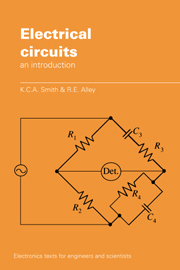Book contents
- Frontmatter
- Contents
- Program listings
- Preface
- 1 Basic concepts, units, and laws of circuit theory
- 2 Theorems and techniques of linear circuit analysis
- 3 Alternating current circuits
- 4 Power and transformers in single-phase circuits
- 5 Three-phase alternating current circuits
- 6 Transient and steady-state analysis
- 7 Non-linear circuit analysis
- 8 Two-port networks
- Appendices
- Bibliography
- Answers to problems
- Index
4 - Power and transformers in single-phase circuits
Published online by Cambridge University Press: 05 June 2012
- Frontmatter
- Contents
- Program listings
- Preface
- 1 Basic concepts, units, and laws of circuit theory
- 2 Theorems and techniques of linear circuit analysis
- 3 Alternating current circuits
- 4 Power and transformers in single-phase circuits
- 5 Three-phase alternating current circuits
- 6 Transient and steady-state analysis
- 7 Non-linear circuit analysis
- 8 Two-port networks
- Appendices
- Bibliography
- Answers to problems
- Index
Summary
Introduction
For the sinusoidal steady state, one can calculate the total power supplied to a circuit consisting of linear elements by adding directly the power absorbed by each individual resistive element in the circuit. However, it is often more convenient to express power in terms of the voltage across and the current supplied to the input terminals of a circuit whose detailed configuration is unknown or is of no interest.
In all electric power distribution networks voltage and frequency are maintained substantially constant. A given load will draw a current whose amplitude and phase (relative to the power line voltage) depend upon the load impedance. On the other hand in electronic and telecommunication networks, signal power rather than voltage is fixed and we are concerned more with arranging source and load conditions to achieve maximum power transfer from one part of a circuit to another.
For the above reasons the treatment of power in electrical circuits depends to a marked extent on the type of circuit under consideration. In this chapter we develop general methods for determining the power and total energy supplied to, or dissipated within, a circuit. We also consider one of the most important components involved in the utilization and transmission of power; namely, the transformer.
Average power
Consider a network or load as shown in fig. 4.1, supplied at voltage V(r.m.s. magnitude V) and drawing current I (r.m.s. magnitude I). If the network contains reactive elements, voltage and current will differ in phase by some angle φ.
Information
- Type
- Chapter
- Information
- Electrical CircuitsAn Introduction, pp. 187 - 230Publisher: Cambridge University PressPrint publication year: 1992
Accessibility standard: Unknown
Why this information is here
This section outlines the accessibility features of this content - including support for screen readers, full keyboard navigation and high-contrast display options. This may not be relevant for you.Accessibility Information
- 1
- Cited by
